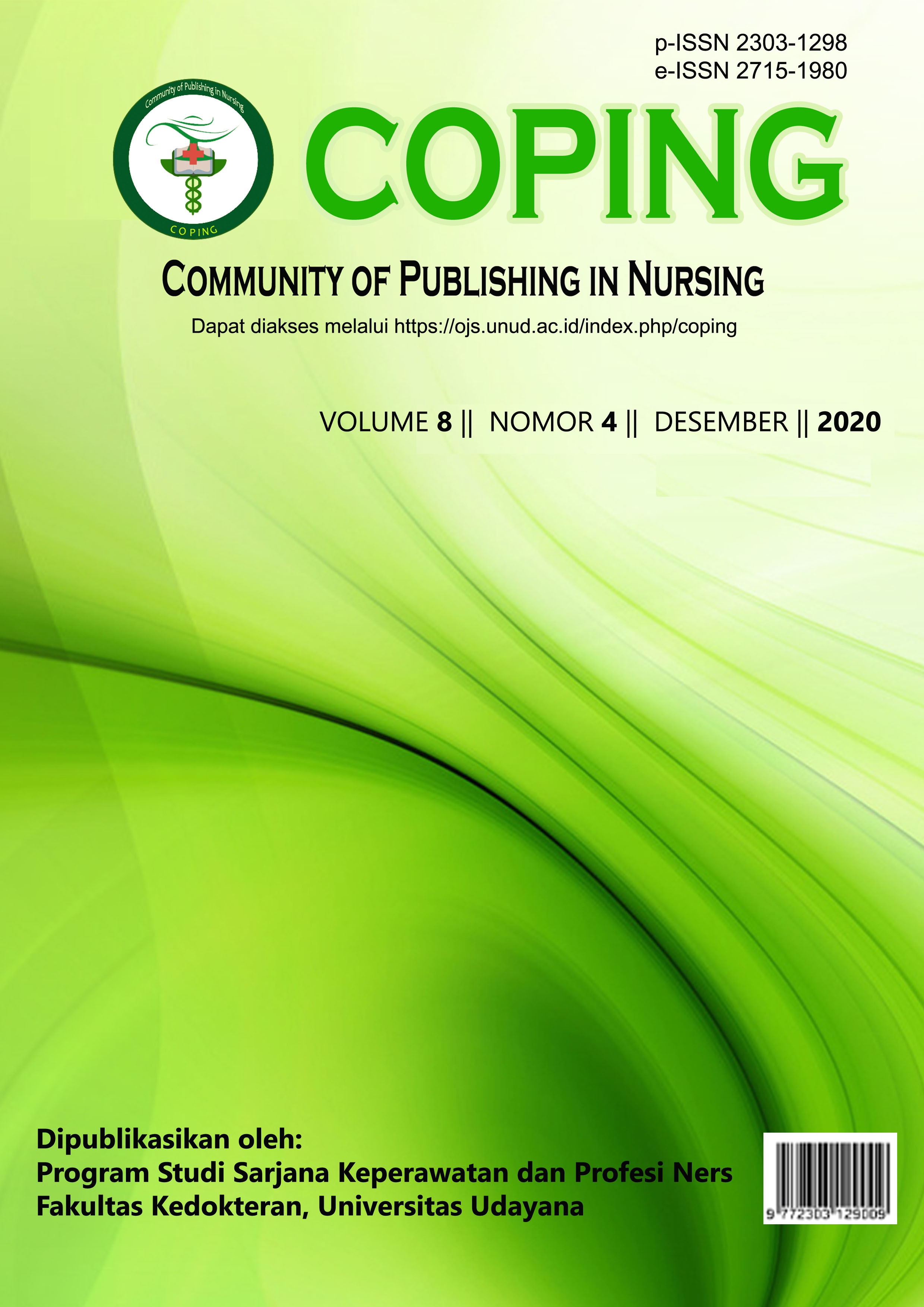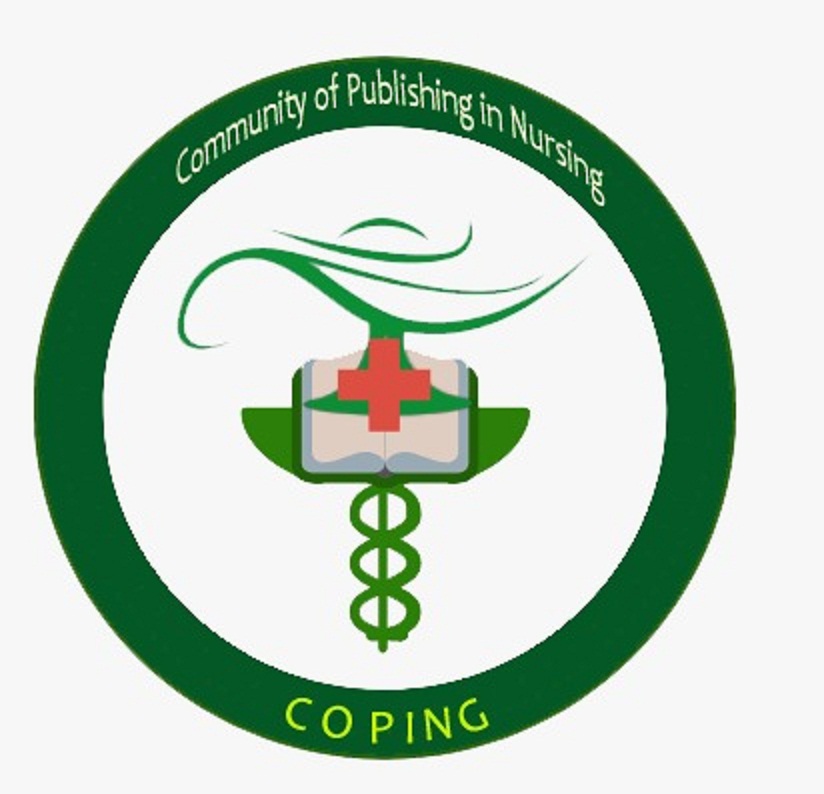A Suicide Prevention: Literature Review
Abstrak
ABSTRACT
Suicide is one of the leading causes of death worldwide. Suicide is an intentional act to end life. Pharmacological, psychological, health education, family support and the media are proposed as effective measures to treat depression and suicide. However, these guidelines do not have sufficient evidence to prevent suicide so this is a challenge for the world of health, especially nursing. The aim of this review is to report the results of studies that focus on interventions undertaken for suicide prevention. The search method for relevant articles uses the database PubMed, Science Direct and Google Scholar using the keywords suicide prevention, suicide intervention, and suicide therapy. Nine articles were included in the literature review, covering various types of suicide intervention, frequency of intervention, and effects of intervention. This literature review identifies eight types of interventions that can be done to prevent suicide, namely ACT, CBT, SAFETY, SOS, ASSIP. The conclusion is that ACT, CBT, SAFETY, SOS, ASSIP interventions can be done to prevent suicide, by increasing knowledge, education, skills regarding suicide and awareness related to suicide and family participation are the main points of interventions that must be carried out to prevent suicide .
Keywords: Prevention of suicide, suicide intervention, suicide therapy
##plugins.generic.usageStats.downloads##
Referensi
Asarnow, J. R., Berk, M., Hughes, J. L., & Anderson, N. L. (2015). The SAFETY Program: A Treatment-Development Trial of a Cognitive-Behavioral Family Treatment for Adolescent Suicide Attempters. Journal of Clinical Child and Adolescent Psychology, 44(1), 194–203. https://doi.org/10.1080/15374416.2014.940624
Asarnow, J. R., Hughes, J. L., Babeva, K. N., & Sugar, C. A. (2017). Cognitive-Behavioral Family Treatment for Suicide Attempt Prevention: A Randomized Controlled Trial. Journal of the American Academy of Child and Adolescent Psychiatry, 56(6), 506–514. https://doi.org/10.1016/j.jaac.2017.03.015
Bachmann, S. (2018). Epidemiology of suicide and the psychiatric perspective. International Journal of Environmental Research and Public Health, 15(7), 1–23. https://doi.org/10.3390/ijerph15071425
Blades, C. A., Stritzke, W. G. K., Page, A. C., & Brown, J. D. (2018). The benefits and risks of asking research participants about suicide: A meta-analysis of the impact of exposure to suicide-related content. Clinical Psychology Review, 64, 1–12. https://doi.org/10.1016/j.cpr.2018.07.001
Ducasse, D., Dassa, D., Courtet, P., Brand-Arpon, V., Walter, A., Guillaume, S., Jaussent, I., & Olié, E. (2019). Gratitude diary for the management of suicidal inpatients: A randomized controlled trial. Depression and Anxiety, 36(5), 400–411. https://doi.org/10.1002/da.22877
Ducasse, D., Jaussent, I., Arpon-Brand, V., Vienot, M., Laglaoui, C., Béziat, S., Calati, R., Carrière, I., Guillaume, S., Courtet, P., & Olié, E. (2018). Acceptance and commitment therapy for the management of suicidal patients: A randomized controlled trial. Psychotherapy and Psychosomatics, 87(4), 211–222. https://doi.org/10.1159/000488715
Fitzpatrick, S. J., & River, J. (2018). Beyond the Medical Model: Future Directions for Suicide Intervention Services. International Journal of Health Services, 48(1), 189–203. https://doi.org/10.1177/0020731417716086
Grupp-Phelan, J., Stevens, J., Boyd, S., Cohen, D. M., Ammerman, R. T., Liddy-Hicks, S., Heck, K., Marcus, S. C., Stone, L., Campo, J. V., & Bridge, J. A. (2019). Effect of a Motivational Interviewing-Based Intervention on Initiation of Mental Health Treatment and Mental Health After an Emergency Department Visit Among Suicidal Adolescents: A Randomized Clinical Trial. JAMA Network Open, 2(12), e1917941. https://doi.org/10.1001/jamanetworkopen.2019.17941
Larsen, M. E., Shand, F., Morley, K., Batterham, P. J., Petrie, K., Reda, B., Berrouiguet, S., Haber, P. S., Carter, G., & Christensen, H. (2017). A Mobile Text Message Intervention to Reduce Repeat Suicidal Episodes: Design and Development of Reconnecting After a Suicide Attempt (RAFT). JMIR Mental Health, 4(4), e56. https://doi.org/10.2196/mental.7500
Luxton, D. D., Smolenski, D. J., Reger, M. A., Relova, R. M. V., & Skopp, N. A. (2020). Caring E-mails for Military and Veteran Suicide Prevention: A Randomized Controlled Trial. Suicide and Life-Threatening Behavior, 50(1), 300–314. https://doi.org/10.1111/sltb.12589
McCauley, E., Berk, M. S., Asarnow, J. R., Adrian, M., Cohen, J., Korslund, K., Avina, C., Hughes, J., Harned, M., Gallop, R., & Linehan, M. M. (2018). Efficacy of dialectical behavior therapy for adolescents at high risk for suicide a randomized clinical trial. JAMA Psychiatry, 75(8), 777–785. https://doi.org/10.1001/jamapsychiatry.2018.1109
Michel, K., Valach, L., & Gysin-Maillart, A. (2017). A novel therapy for people who attempt suicide and why we need new models of suicide. International Journal of Environmental Research and Public Health, 14(3). https://doi.org/10.3390/ijerph14030243
Mulyani, A. A., & Eridiana, W. (2019). Faktor-Faktor Yang Melatarbelakangi Fenomena Bunuh Diri Di Gunungkidul. Sosietas, 8(2), 510–516. https://doi.org/10.17509/sosietas.v8i2.14593
Na, K. S., Park, S. C., Kwon, S. J., Kim, M., Kim, H. J., Baik, M., Seol, J., An, E. J., Lee, S. M., Lee, E. J., Lim, M., Cho, S. J., Kim, G. H., Kim, N., Jeon, H. J., Paik, J. W., Oh, K. S., & Lee, H. Y. (2020). Contents of the standardized suicide prevention program for gatekeeper intervention in Korea, version 2.0. Psychiatry Investigation, 17(11), 1149–1157. https://doi.org/10.30773/pi.2020.0271
Niederkrotenthaler, T., & Till, B. (2020). Effects of suicide awareness materials on individuals with recent suicidal ideation or attempt: online randomised controlled trial. The British Journal of Psychiatry, 217(6), 693–700. https://doi.org/10.1192/bjp.2019.259
Pusat Data dan Informasi Kementrian Kesehatan Republik Indonesia. (2019). Situasi dan Pencegahan Bunuh Diri (pp. 1–10).
Robinson, J., Cox, G., Bailey, E., Hetrick, S., Rodrigues, M., Fisher, S., & Herrman, H. (2016). Social media and suicide prevention: A systematic review. Early Intervention in Psychiatry, 10(2), 103–121. https://doi.org/10.1111/eip.12229
Sander, L., Gerhardinger, K., Bailey, E., Robinson, J., Lin, J., Cuijpers, P., & Mühlmann, C. (2020). Suicide risk management in research on internet-based interventions for depression: A synthesis of the current state and recommendations for future research. Journal of Affective Disorders, 263, 676–683. https://doi.org/10.1016/j.jad.2019.11.045
Schilling, E. A., Aseltine, R. H., & James, A. (2016). The SOS suicide prevention program: Further evidence of efficacy and effectiveness. Prevention Science, 17(2), 157–166. https://doi.org/10.1007/s11121-015-0594-3
Sheng, K., Zhang, P., Chen, L., Cheng, J., Wu, C., & Chen, J. (2014). Intradialytic exercise in hemodialysis patients: A systematic review and meta-analysis. American Journal of Nephrology, 40(5), 478–490. https://doi.org/10.1159/000368722
Weinstein, S. M., Cruz, R. A., Isaia, A. R., Peters, A. T., & West, A. E. (2018). Child- and Family-Focused Cognitive Behavioral Therapy for Pediatric Bipolar Disorder: Applications for Suicide Prevention. Suicide and Life-Threatening Behavior, 48(6), 797–811. https://doi.org/10.1111/sltb.12416
World Health Organization. (2019). Suicide in the world: Global Health Estimates. World Health Organization,Geneva, 32.
Wulandari, I. S., Ratnawati, R., Supriyati, L., & Kumboyono. (2014). Pengalaman Perawat Instalasi Gawat Darurat dalam Merawat Pasien Percobaan Bunuh Diri di Rumah Sakit Dr. Moewardi Surakarta. Jurnal KesMaDaSka, 10.
Xue, C., Yang, Y., Xu, K., Shi, X., & Liu, H. (2020). Health personnel-targeted education interventions on inpatient suicide prevention in general hospitals: A scoping review. International Journal of Nursing Sciences, 7(4), 477–483. https://doi.org/10.1016/j.ijnss.2020.09.006








